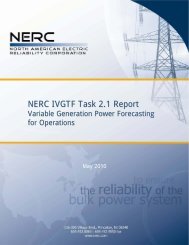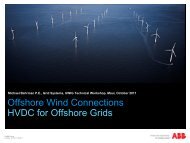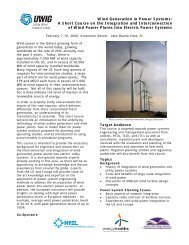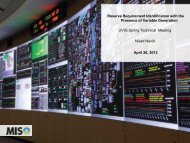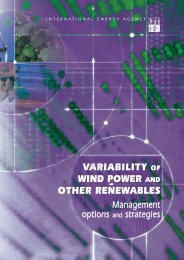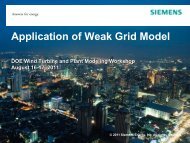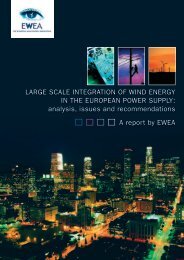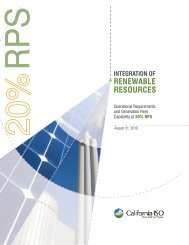Integrating Southwest Power Pool Wind to Southeast Electricity ...
Integrating Southwest Power Pool Wind to Southeast Electricity ...
Integrating Southwest Power Pool Wind to Southeast Electricity ...
Create successful ePaper yourself
Turn your PDF publications into a flip-book with our unique Google optimized e-Paper software.
6<br />
CONCLUSIONS AND RECOMMENDED NEXT STEPS<br />
The objective of this study is <strong>to</strong> evaluate the balancing/scheduling impact of high levels of wind<br />
generation in SPP for consumption and export <strong>to</strong> SERC and <strong>to</strong> evaluate the benefits of increased<br />
coordination in scheduling, balancing and reserve provision across the SPP/SERC region. To this<br />
end, a detailed UC/ED model of the SPP/SERC region was developed and utilized <strong>to</strong> run<br />
production cost simulations for different high wind transfer scenarios. As in any study like this,<br />
modeling and data input assumptions have a significant impact on results. These assumptions<br />
have been noted in this report with the presentation of the simulation results, but the following<br />
most crucial assumptions provide context for the subsequent conclusions:<br />
• Unconstrained transmission. Thermal constraints are removed and losses ignored for the<br />
SPP/SERC network in the SCUC/SCED model for which results are presented. Analysis<br />
<strong>to</strong> quantify the effect of unconstraining the transmission with low wind levels shows that<br />
the assumption results in greater utilization of those resources modeled as cheaper across<br />
the study footprint and subsequent larger economic energy flows between regions. It’s<br />
noted, however, that any high wind build-out would necessarily be accompanied by a<br />
significant transmission build-out that would in fact enable additional flows within and<br />
between regions, just not <strong>to</strong> the extent modeled in this work.<br />
• Gas and emission prices. The fuel price was shown <strong>to</strong> be important with the gas price<br />
sensitivity. While there is always likely <strong>to</strong> be a benefit from sharing reserve requirements<br />
and thus reducing them, fuel prices may change how significant the benefit is. This is<br />
seen in the fact that with reduced gas prices, CC production barely changes in <strong>to</strong>tal, but<br />
does shift from one region <strong>to</strong> another. Carbon prices would also impact results. Higher<br />
carbon prices would make coal less attractive and therefore the benefits of being able <strong>to</strong><br />
use coal more with shared reserve requirements would be reduced.<br />
• Reserve margin and conventional generation plant mix. The additional 40 GW of wind<br />
was added <strong>to</strong> the High <strong>Wind</strong> Transfer cases without removing any of the conventional<br />
generation in the 2022 Non-RES case resulting in a reserve margin in the model which<br />
would likely be higher than that which would be seen in reality. In reality, the additional<br />
wind would likely displace some conventional generation. Assuming for example a<br />
capacity credit of 10% for the 40GW of wind added <strong>to</strong> the 7 GW case, then 4 GW of<br />
conventional plant would not be required <strong>to</strong> maintain capacity adequacy at the same<br />
level. This could lead <strong>to</strong> a reduction in the CC units which are shown <strong>to</strong> be the main<br />
units used <strong>to</strong> provide the increased reserve and ramping needed for high penetrations of<br />
wind. In addition, the plant mix for the conventional generation assumed in the model is<br />
an important assumption. Although the model is based on the best information available<br />
6-1




